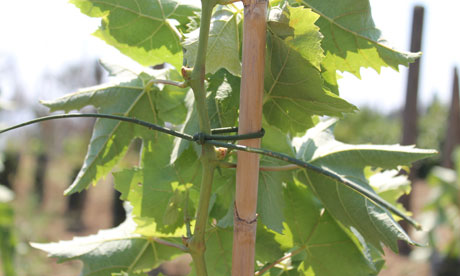Virgil and Columella Guide Experimental Winemakers
Friday, August 23, 2013

(Wikimedia Commons)
Ed ecco l'articolo del link:
Italian archaeologists have grape expectations* of their ancient wine
*(Gioco di parole su: 'great expectations')
Scientists plant vineyards with the aim of making wine using techniques from classical Rome described by Virgil
Scientists plant vineyards with the aim of making wine using techniques from classical Rome described by Virgil

The University of Catania's vines are secured with canes and woven juniper leaves. Photograph: Mario Indelicato
Archeologists in Italy have set about making red wine exactly as the ancient Romans did, to see what it tastes like.
Based at the University of Catania in Sicily and supported by Italy's national research centre, a team has planted a vineyard near Catania using techniques copied from ancient texts and expects its first vintage within four years.
"We are more used to archeological digs but wanted to make society more aware of our work, otherwise we risk being seen as extraterrestrials," said archaeologist Daniele Malfitana.
At the group's vineyard, which should produce 70 litres at the first harvest, modern chemicals will be banned and vines will be planted using wooden Roman tools and will be fastened with canes and broom, as the Romans did.
Instead of fermenting in barrels, the wine will be placed in large terracotta pots – traditionally big enough to hold a man – which are buried to the neck in the ground, lined inside with beeswax to make them impermeable and left open during fermentation before being sealed shut with clay or resin.
"We will not use fermenting agents, but rely on the fermentation of the grapes themselves, which will make it as hit and miss as it was then – you can call this experimental archaeology," said researcher Mario Indelicato, who is managing the programme.
The team has faithfully followed tips on wine growing given by Virgil in the Georgics, his poem about agriculture, as well as by Columella, a first century AD grower, whose detailed guide to winemaking was relied on until the 17th century.
"We have found that Roman techniques were more or less in use in Sicily up until a few decades ago, showing how advanced the Romans were," said Indelicato. "I discovered a two-pointed hoe at my family house on Mount Etna recently that was identical to one we found during a Roman excavation."
What has changed are the types of grape varieties, which have intermingled over the centuries. "Columella mentions 50 types but we can only speculate on the modern-day equivalents," said Indelicato, who is planting a local variety, Nerello Mascalese.
"To sweeten up their wine, which could be vinegary, the Romans added honey and water to it," he said. "They made better stuff for nobles and cheaper, more vinegary stuff for slaves. We will try and make both types."
The drinking habits of Romans have also changed in two millennia. Whereas Italians today drink moderately with meals, their ancestors were more given to drunken carousing.
"An edict was issued in the first century AD halting the planting of vineyards because people were not growing wheat any more," said Indelicato.
"The Romans took the concept of getting together for a drink from the Greeks after they conquered the Greek-controlled Italian city of Taranto in the third century BC.
"They drank at festivals to mark the pending harvest, after the harvest. In fact, any occasion was good for a drink."
